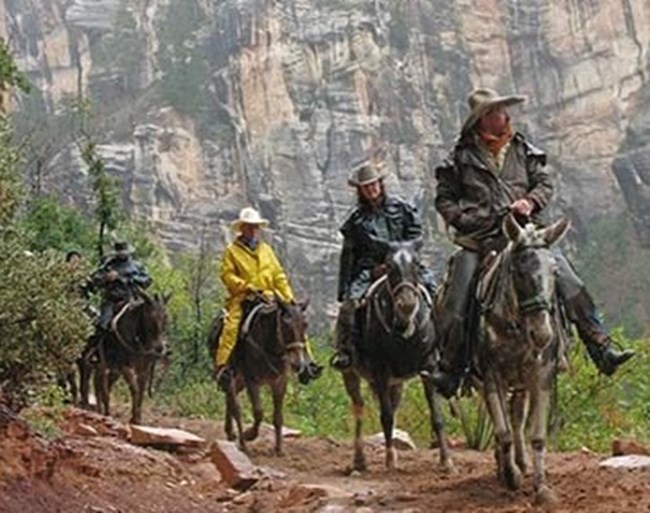Last updated: January 3, 2024
Article
Equine Manure Management and Environmental Impacts

Pack animals walk up and down trails to deliver supplies to remote areas of the park and carry visitors to and from their destinations. These hard-working equines improve the visitor experience and provide essential supplies where visitors would otherwise go without. Concessioners who manage stock are responsible for minimizing the impact to area resources caused by the use of equine animals.With equine stock comes manure management. Humans are instructed to leave no trace along the trail but what about equines? All users of park lands can alter the ecosystems in the park. Concessioners who operate equine pack and riding operations should follow Leave No Trace Principles for Stock.
Manure on Trail
Scatter, rake, and disperse manure from the trail when possible in the backcountry. Multi-use trails are enjoyed by others on foot and bikes. Other trail users do not want to step in or run over manure! In high traffic areas and at trailheads, clear the trail of manure as soon as possible, especially in high traffic areas. Not only does clearing manure keep trails enjoyable for others, but it also aerates the manure preventing flies (and larvae) from gathering and reduces the risk of polluting water ways. Horse manure is unlikely to spread any disease to people. Dangerous bacteria found in equine manure like E. coli is killed in sunlight. When properly dispersed, manure is unlikely to spread disease.Disperse manure piles away from camp daily. Whether manure is on the trail or near camp, the same environmental impacts exist. Manure within a quarter of a mile of the trail head or stable is often removed from the trail and carried back the stable. However, concessioners should check their operating plan for specific areas from which manure should be removed. Be a good steward to resources and remove manure from the trail when possible.
Manure in the Environment
What impact does manure have on natural landscapes? Equine manure contains nitrogen, phosphorus, and carbon. These nutrients can be beneficial when managed and processed properly and are often used as fertilizer for crops. When not managed properly, equine manure can pollute the environment, mainly as ground or surface water pollution due to the contents of the manure. Nitrogen, phosphorus, and carbon can reach waterways as surface runoff or leach from the manure pile into the environment. If ammonia from horse manure comes into contact with surface waters, it can cause excessive algae growth ultimately harming the waterways.
Stock Care
Weed free feed is important and a key element of the horse and mule periodic evaluation standards. Non-weed free hay can introduce invasive noxious weeds. These species of plants are destructive and difficult to eradicate and control. Noxious weeds compete with native vegetation for nutrients and space, increasing soil erosion and decreasing biodiversity. These invasive weeds can be easily spread through manure containing invasive weed seeds.Consider natural, ecofriendly fly repellent for horses. A University of Minnesota study found that reusable leggings with active ingredients like citronella worked best to protect stock from flies. Using a fly repellent keeps equines clean, comfortable, and reduces the risk of diseases.
Composting Manure
Equine animals produce between 30 to 70 pounds of waste daily. Composting manure is an ecofriendly, low-cost way to manage manure in and around stables and pastures. When managed properly, manure can be a valuable resource. Manure can be a source of nutrients for crop production and can improve soil quality. When you compost organic matter, you create a combination of heat, chemicals, and beneficial bacteria that morphs it from decaying manure and waste into rich soil.When choosing a compost area, identify an area that is close to corrals and stables so manure can be transported easily. Ensure your compost does not accumulate too much moisture. Too much moisture leads to a slower composting process and odor as microbes do not get the oxygen needed to break down into compost matter. Ensure drainage does not lead to any body of water, streams, or rivers.Concessioners should seek out local community composting operations, farms, and other partners in order to use composted manure to the greatest extent possible. Both small and large scale farmers can use manure onsite by spreading it as a fertilizer on an open area, pasture or field. Other uses include potting soil, tree mulching, and yard fertilizer. Composting operations are inherently local, concessioners should research composting partners and operations by county, city, and state.
Resources
Learn more about noxious weeds and invasive plants at nps.gov/subjects/invasive/plants. Review the free, one hour course specific to stock use provided by Leave No Trace. Visit epa.gov to learn more about managing and reducing methane emissions from livestock manure.
